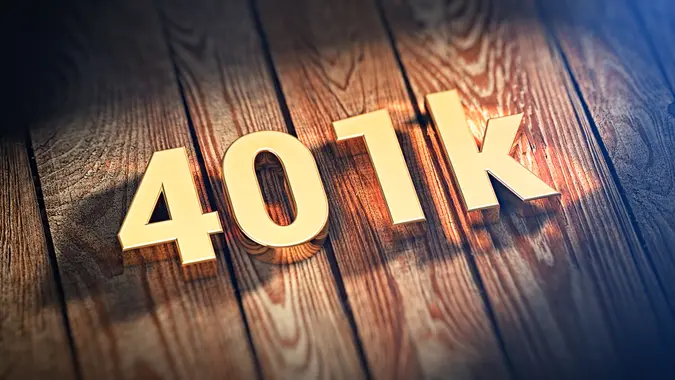9 Best Retirement Plans for October 2024

Commitment to Our Readers
GOBankingRates' editorial team is committed to bringing you unbiased reviews and information. We use data-driven methodologies to evaluate financial products and services - our reviews and ratings are not influenced by advertisers. You can read more about our editorial guidelines and our products and services review methodology.

20 Years
Helping You Live Richer

Reviewed
by Experts

Trusted by
Millions of Readers
Planning for retirement is an important financial step, and you have plenty of options to choose from when selecting a retirement plan.
Understanding how these accounts work and the benefits they offer are an important part of the process. Here’s a look at the top nine types of retirement plans.
What Are the Best Retirement Plans?
Some retirement plans are designed for people with full-time jobs. Some are meant exclusively for business owners. Others are adaptable to anyone, no matter their situation. Each has its own benefits and drawbacks.
1. Traditional IRA
An individual retirement account is a savings plan that any individual with a taxable income can open and manage themselves.
The money you contribute to a traditional IRA grows tax-free, so you won’t pay taxes until you withdraw it, an advantage if you’re in a higher tax bracket now than you plan to be in retirement.
You can open a traditional IRA at a bank, credit union or brokerage. This makes traditional IRAs accessible to anyone, and they give you the freedom to choose the investment options you can afford.
2. Roth IRA
A Roth IRA is similar to a traditional IRA. The primary difference between them is that with a Roth IRA, you pay taxes on contributions as you make them instead of when you withdraw the money upon retirement. If you’re in a lower tax bracket now than you expect to be in retirement, a Roth IRA can offer some tax advantages.
Also, unlike some of the alternatives, a Roth IRA will allow you to start withdrawing your contributions to the account early under certain circumstances. Roth IRAs are also accessible for most people, as you can open an account at many banks, credit unions and brokerages.
3. SEP-IRA
A Simplified Employee Pension IRA has a similar structure to a traditional IRA. The main difference is that it’s designed so that small businesses can set up and administer a retirement account for employees without the high costs associated with other employer-sponsored plans. As of 2024, the employer is allowed to contribute 25% of an employee’s income up to a maximum amount of $69,000.
Given that the contribution is dependent on income, in years when the business makes less money, you can make smaller contributions. This is beneficial if you are the employer, but less so if you are the employee.
4. SIMPLE IRA
A Savings Incentive Match Plan for Employees IRA is also intended for use by small-business owners. To qualify for a SIMPLE IRA, a business must have no more than 100 employees and not offer another retirement plan.
Under this plan, the employer must contribute to the account each year — either a 2% nonelective contribution or up to a 3% match of each employee’s compensation. If an employee leaves the company, they keep all contributions made.
5. 401(k)
A 401(k) is the most common retirement plan offered by employers. A 401(k) is tax-free until you are ready to withdraw the money, at which point you pay income tax on the amount you take out.
Many employers match contributions that you make into a 401(k). You may not be allowed to keep all of your employer’s contributions if you leave the company before you are fully vested. However, you can roll over contributions into your new employer’s 401(k) plan or into an IRA.
6. Solo 401(k)
A solo 401(k) is similar to a standard 401(k), but it’s for self-employed individuals with no employees. That means you can make contributions as both an employer and an employee — which translates to potentially more tax-deferred savings than you’re allowed with a standard 401(k).
You can contribute as much as 100% of your earned income from self-employment, up to contribution limits — $23,000 in 2024, plus a catch-up contribution of $7,500 if you’re age 50 or older. The limit on your contributions as an employer is 25% of your employee compensation from the business, up to $69,000, plus a catch-up contribution.
7. 403(b)
A 403(b) plan is offered to employees of public schools and certain nonprofits, such as churches and 501(c)(3) organizations. As with 401(k) contributions, 403(b) contributions are tax-deferred, and so is the growth of funds in your account. You’re not taxed until you withdraw the money.
Some employers offer Roth versions in addition to standard 403(b)s. With a Roth 403(b) account, you make contributions from after-tax income and withdraw funds tax-free in retirement.
8. Annuity
Annuities are contracts with insurance companies. In exchange for your purchase paid through a lump sum or in installments, the insurance company agrees to make one or more payments to you. You can take the payout as a lump sum or as a series of payments.
There are three primary types of annuities:
- Indexed annuity: Returns are tied to an index, such as the S&P 500
- Fixed annuity: Offers a fixed interest rate on your funds and periodic payments of a predetermined dollar amount
- Variable annuity: Allows the insurance company to invest your funds, which grow tax-free at a variable interest rate
9. Defined Benefit Plan
A defined benefit plan is the type of retirement plan most people probably associate with employee pensions. Recipients receive a fixed, predetermined benefit when they retire based on a set dollar amount or a percentage of their salary. With a defined benefit plan, your employer contributes most of the funds, and you know in advance how much you’ll receive when you retire.
Other Options for Retirement
These retirement plans tend to be better known and more common than other options, but you can set aside money in additional accounts to pay for expenses during retirement. For example, if you still have money left over in a 529 plan used to pay for your education expenses, you may be able to transfer that money to a Roth IRA.
Another valuable account to consider is a health savings account. You contribute tax-free money to the HSA, and it grows tax-free. You can avoid paying taxes on withdrawals as long as you use the money to cover qualified medical expenses.
Benefits To Consider When Choosing a Retirement Plan
Retirement plans are not one-size-fits-all, so it’s important to choose the combination of accounts that can help you achieve your retirement goals. By definition, all retirement plans are tax-advantaged, but it’s helpful to know when you will pay taxes on the withdrawals you make.
If you’re decades away from retirement and earning an entry-level salary, you may prefer paying taxes now by contributing to a Roth account. If you’re at the end of your career, it may make more sense to defer tax payments until you’re making withdrawals at your lower retirement-era tax bracket.
If you’re self-employed, setting up a retirement account is essential since you don’t have an employer offering this benefit. Conversely, if your employer matches contributions to your retirement account, take advantage of it. The money in your 401(k) is all yours after you’re fully vested, so it’s essentially free money.
Investment Strategies for Retirement
The best investment strategy for retirement is to start saving whatever you can put away now. This gives your money more time to grow. If your employer offers a retirement plan, take advantage of your employer’s plan, especially if they match what you put in. Then begin maximizing your annual contributions each year to an IRA and your 401(k), if you have one. Your financial advisor can help you understand your options.
FAQ
- What is the most common type of retirement plan?
- A 401(k) is the most common type of retirement plan offered by employers, edging out defined benefit plans, according to an IBISWorld analysis.
- What is the simplest retirement plan?
- A traditional IRA is the most straightforward retirement plan. Anyone who earns an income can open one, so there are fewer hoops to jump through to see if you qualify.
- What retirement plan is better than a 401(k)?
- A retirement plan is a personal choice, dependent on when you would rather be taxed and what kind of employer contributions you expect. The best plan for a business owner is not the best plan for an employee, so deciding if a 401(k) or another retirement account type is best requires research or the advice of a professional.
- What is the difference between a 403(b) and a 401(k)?
- The primary difference between a 403(b) and a 401(k) is the type of employer that offers them. Public schools and certain charitable organizations sponsor 403(b) plans, while for-profit companies sponsor 401(k)s.
- Is a Roth IRA better than a 401(k)?
- They're different products, and one isn't necessarily better than the other. Roth IRAs have the benefit of being individual plans — you don't need an employer to sponsor one. In addition, you withdraw money tax-free in retirement. The main benefits of a 401(k) are the higher contribution limits and your employer's ability to contribute funds on your behalf.
Allison Hache and Monica White contributed to the reporting for this article.
Our in-house research team and on-site financial experts work together to create content that’s accurate, impartial, and up to date. We fact-check every single statistic, quote and fact using trusted primary resources to make sure the information we provide is correct. You can learn more about GOBankingRates’ processes and standards in our editorial policy.
- IRS. 2024. "One-participant 401(k) plans."
- IRS. 2024. "IRC 403(b) tax-sheltered annuity plans."
- IRS. 2024. "Publication 590-A (2023), Contributions to Individual Retirement Arrangements (IRAs)."
- IRS. 2024. "Publication 969 (2023), Health Savings Accounts and Other Tax-Favored Health Plans."
- IRS. 2024. "Traditional and Roth IRAs."
- IRS. 2024. "Simplified Employee Pension plan (SEP)."
- IRS. 2024. "SIMPLE IRA plan."
- IRS. 2024. "Defined benefit plan."
 Written by
Written by  Edited by
Edited by 

























